Evaluating the return on investment (ROI) of paid versus organic App Store Optimization (ASO) strategies is essential for maximizing app visibility and revenue. Paid ASO strategies require direct financial investment for immediate results, while organic strategies focus on optimizing app listings to attract users without upfront costs. Understanding the ROI for both approaches involves analyzing revenue generated from installs against the respective costs, enabling informed decisions on resource allocation for optimal growth.
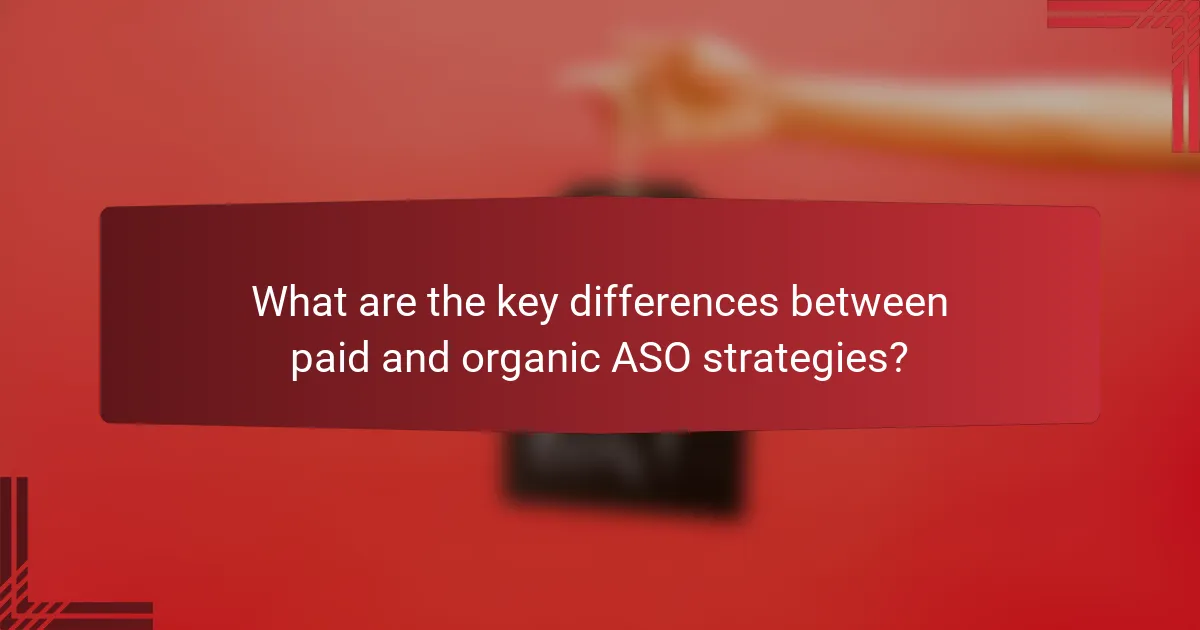
What are the key differences between paid and organic ASO strategies?
Paid and organic ASO strategies differ primarily in their cost, approach to traffic generation, and the duration of their benefits. Paid strategies involve direct financial investment for immediate visibility, while organic strategies focus on optimizing app store listings to attract users without direct costs.
Cost structure comparison
Paid ASO strategies typically require a budget for advertisements, which can vary widely based on competition and target audience. Costs may range from a few hundred to several thousand dollars per month, depending on the scale of the campaign and the platforms used.
In contrast, organic ASO strategies involve minimal direct costs but require significant time and effort for optimization. This includes keyword research, A/B testing of app icons and descriptions, and ongoing performance analysis, which can be resource-intensive but ultimately cost-effective.
Traffic generation methods
Paid ASO strategies generate traffic through targeted ads, such as Apple Search Ads or Google Ads, allowing for immediate visibility in search results. This method can quickly drive downloads but requires continuous funding to maintain visibility.
Organic ASO relies on optimizing app metadata, such as titles, keywords, and descriptions, to improve rankings in app store search results. This method builds sustainable traffic over time as the app gains visibility through user engagement and positive reviews.
Long-term vs. short-term benefits
Paid ASO offers short-term benefits by quickly increasing app visibility and downloads, which can lead to immediate revenue. However, once the budget runs out, visibility may decline rapidly.
Organic ASO, on the other hand, focuses on long-term growth. While it may take time to see results, a well-optimized app can maintain visibility and downloads without ongoing costs, leading to a more sustainable user base.
Market competition impact
The level of competition in the app market significantly influences both paid and organic ASO strategies. In highly competitive markets, paid strategies may be necessary to gain initial traction, as organic methods can take longer to yield results.
For organic ASO, understanding the competitive landscape is crucial for effective keyword selection and optimization. Apps in less saturated niches may find it easier to rank organically, while those in crowded markets must continually adapt their strategies to maintain visibility.
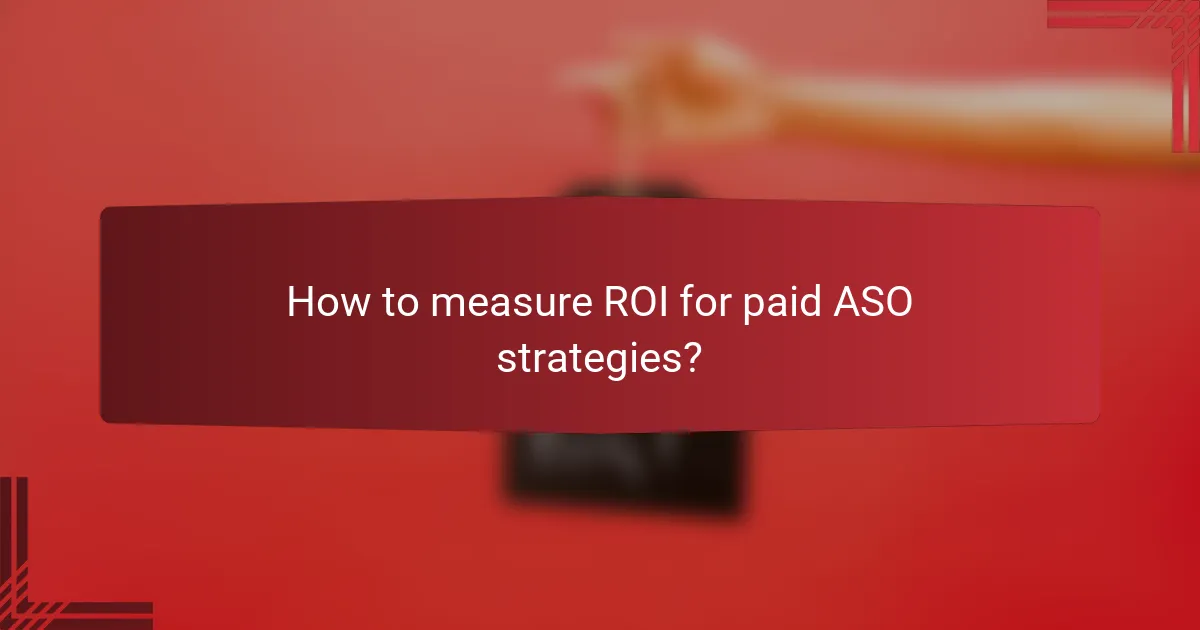
How to measure ROI for paid ASO strategies?
Measuring ROI for paid ASO strategies involves analyzing the revenue generated from app installs against the costs incurred for advertising. This evaluation helps determine the effectiveness of your investment in paid strategies compared to organic growth.
Key performance indicators for paid ASO
Key performance indicators (KPIs) for paid ASO include metrics such as cost per install (CPI), return on ad spend (ROAS), and conversion rates. These KPIs provide insights into how well your paid campaigns are performing and their impact on overall app visibility and downloads.
Tracking these indicators allows you to assess the profitability of your campaigns. For example, a low CPI combined with a high ROAS indicates a successful paid strategy, while high costs with low returns may signal the need for adjustments.
Calculating cost per acquisition
Cost per acquisition (CPA) is calculated by dividing the total advertising spend by the number of new users acquired through that spend. For instance, if you spent $1,000 on ads and gained 200 new users, your CPA would be $5.
Understanding CPA helps in budgeting and forecasting. Aim for a CPA that is lower than the lifetime value (LTV) of a user to ensure profitability. Regularly monitor this metric to identify trends and optimize your ad spend accordingly.
Tools for tracking paid ASO performance
Several tools can help track paid ASO performance effectively. Platforms like App Annie, Sensor Tower, and Adjust provide comprehensive analytics for monitoring KPIs, user acquisition, and revenue metrics.
Utilizing these tools allows for real-time data analysis, enabling quick adjustments to campaigns. Consider integrating multiple tools to gain a holistic view of your paid ASO efforts and enhance decision-making based on accurate insights.
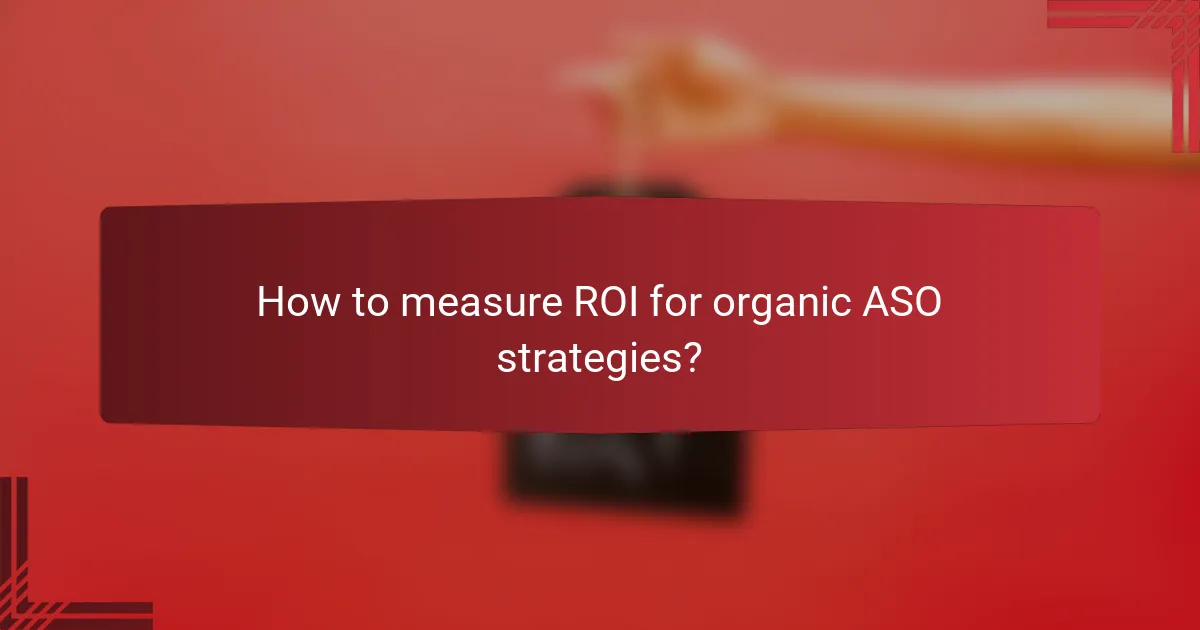
How to measure ROI for organic ASO strategies?
Measuring ROI for organic ASO strategies involves analyzing the revenue generated from organic downloads against the costs associated with optimizing your app’s visibility. This includes tracking user acquisition, engagement, and retention metrics to determine the overall effectiveness of your organic efforts.
Key performance indicators for organic ASO
Key performance indicators (KPIs) for organic ASO include organic download rates, conversion rates, and user retention rates. Monitoring these metrics helps assess how well your app is performing in search results and how effectively it converts views into downloads.
Additionally, tracking the average revenue per user (ARPU) can provide insights into the financial impact of your organic ASO strategies. A higher ARPU indicates that your organic users are engaging more and generating more revenue.
Estimating lifetime value of organic users
Estimating the lifetime value (LTV) of organic users is crucial for understanding the long-term benefits of your ASO efforts. LTV can be calculated by multiplying the average revenue per user by the average user lifespan. This helps in determining how much you can invest in acquiring organic users while still maintaining profitability.
Consider using a range for LTV estimates, as it can vary significantly based on user engagement and retention. For example, LTV for mobile apps can range from a few dollars to several hundred dollars, depending on the app category and user behavior.
Tools for tracking organic ASO performance
Several tools can help track organic ASO performance effectively. Platforms like App Annie, Sensor Tower, and Mobile Action provide insights into keyword rankings, download estimates, and competitive analysis. These tools can help you identify which keywords drive the most organic traffic and how your app ranks against competitors.
Additionally, using analytics tools like Google Analytics or Firebase can help monitor user behavior post-download, allowing you to assess retention rates and user engagement. Combining these insights will give you a comprehensive view of your organic ASO performance.

What are the best practices for optimizing paid ASO campaigns?
To optimize paid ASO campaigns effectively, focus on understanding your target audience, refining ad copy and creative elements, and strategically allocating your budget. These practices can significantly enhance the return on investment (ROI) of your campaigns.
Target audience segmentation
Segmenting your target audience allows for more tailored ad campaigns that resonate with specific user groups. Consider demographics such as age, location, and interests to create segments that reflect the diversity of your potential users.
Utilize analytics tools to gather data on user behavior and preferences. This information can guide your campaign strategies, ensuring that your ads reach the most relevant audiences, which can lead to higher engagement and conversion rates.
Ad copy and creative optimization
Effective ad copy and creative elements are crucial in capturing user attention and driving installs. Focus on clear, concise messaging that highlights the unique features and benefits of your app.
Test different variations of your ad copy and visuals to determine what resonates best with your audience. A/B testing can help identify which combinations yield the highest click-through rates and conversions, allowing for continuous improvement.
Budget allocation strategies
Strategically allocating your budget is essential for maximizing the impact of your paid ASO campaigns. Start by determining your overall marketing budget and then allocate funds based on the performance of different channels and campaigns.
Consider using a flexible budget approach, where you can adjust spending based on real-time performance data. This allows you to invest more in high-performing ads while reducing spend on underperforming ones, ultimately optimizing your ROI.
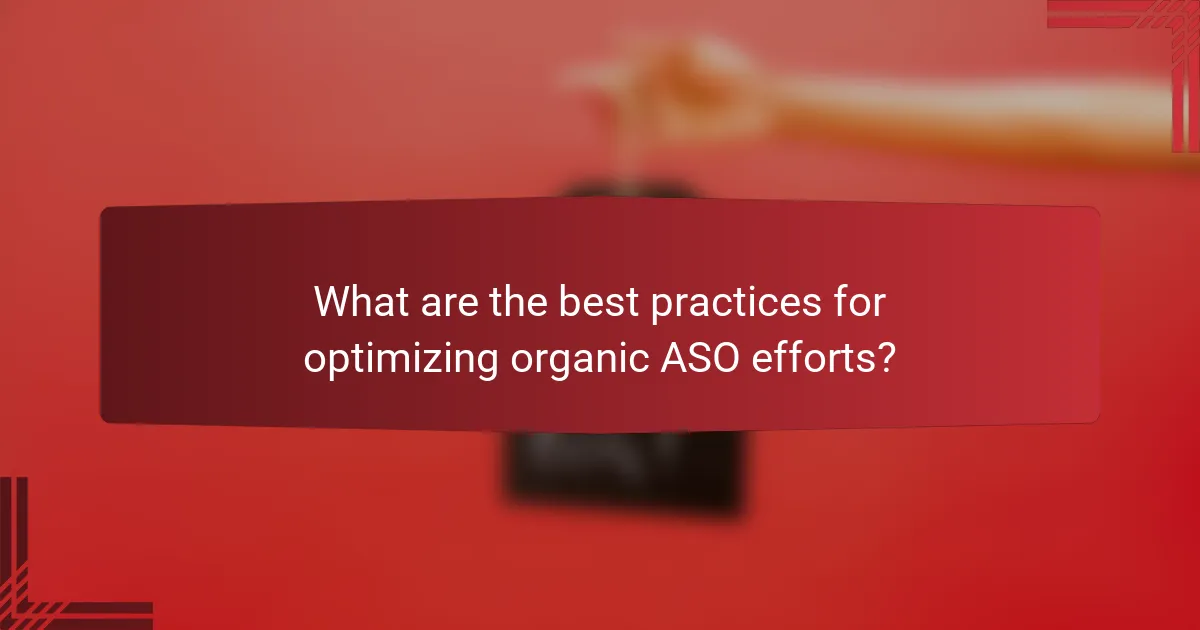
What are the best practices for optimizing organic ASO efforts?
Optimizing organic App Store Optimization (ASO) efforts involves a strategic approach to enhance app visibility and drive downloads without relying on paid advertising. Key practices include thorough keyword research, effective app store listing optimization, and proactive user review management.
Keyword research techniques
Effective keyword research is fundamental for organic ASO. Start by identifying relevant keywords that potential users are likely to search for, using tools like App Annie or Sensor Tower. Focus on a mix of high-volume and low-competition keywords to maximize visibility.
Consider using long-tail keywords, which are more specific phrases that can attract targeted users. For instance, instead of just “fitness app,” try “home workout fitness app for beginners.” Regularly update your keyword list based on trends and user feedback to stay competitive.
App store listing optimization
App store listing optimization involves refining your app’s title, description, and visuals to improve discoverability. Ensure your app title includes primary keywords and is catchy to attract users. The description should clearly convey the app’s benefits and features while incorporating relevant keywords naturally.
High-quality visuals, including screenshots and videos, are essential. They should showcase the app’s functionality and user experience. Aim for a clean, professional design that resonates with your target audience, as this can significantly impact conversion rates.
User review management
Managing user reviews is crucial for maintaining a positive app reputation. Encourage satisfied users to leave positive feedback, as higher ratings can improve your app’s ranking in search results. Respond promptly to reviews, both positive and negative, to show users that you value their input.
Implementing a system for monitoring reviews can help you identify common issues or suggestions for improvement. Regularly analyze feedback to make necessary updates or enhancements, ensuring your app continues to meet user expectations and remains competitive in the market.
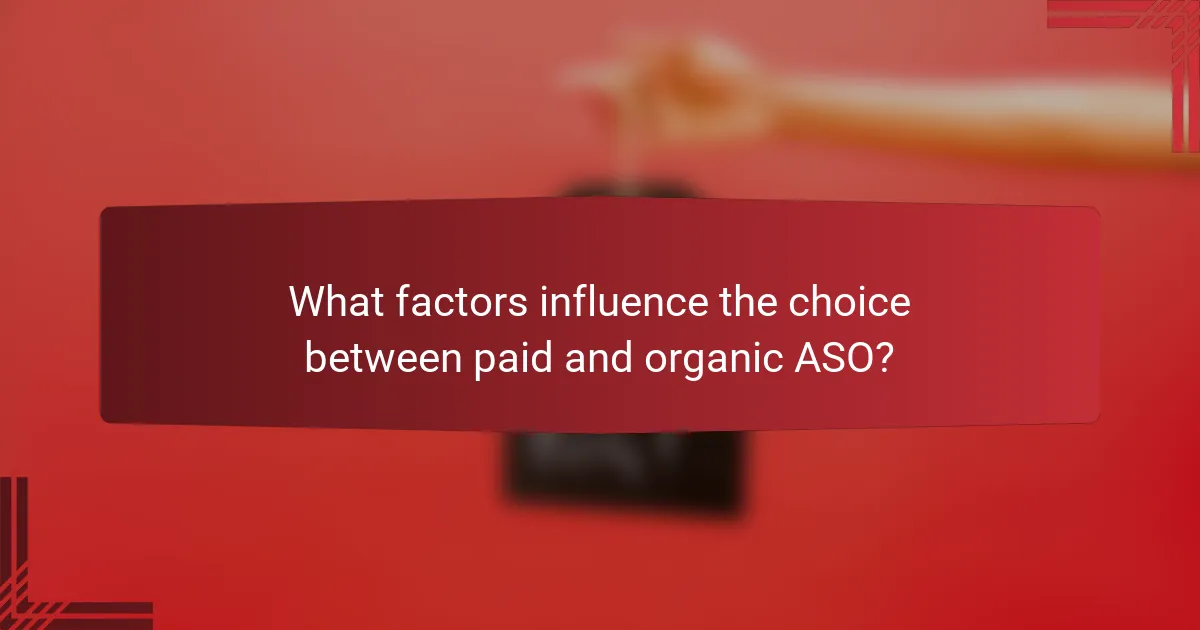
What factors influence the choice between paid and organic ASO?
The choice between paid and organic App Store Optimization (ASO) strategies is influenced by several key factors, including the competitiveness of the app category and the available marketing budget. Understanding these elements can help app developers and marketers make informed decisions that align with their goals and resources.
App category competitiveness
The competitiveness of an app category significantly impacts the effectiveness of paid versus organic ASO strategies. In highly competitive categories, such as games or productivity apps, organic visibility may be challenging to achieve without substantial effort. In such cases, investing in paid ASO can provide immediate visibility and user acquisition.
For example, if your app is in a saturated market, consider allocating a larger portion of your budget to paid advertising to gain traction quickly. Conversely, in less competitive categories, organic strategies may yield better long-term results without the need for ongoing ad spend.
Marketing budget constraints
Your marketing budget plays a crucial role in determining whether to pursue paid or organic ASO. If funds are limited, focusing on organic strategies, such as optimizing keywords and improving app store listings, can be more sustainable. This approach allows for gradual growth without incurring high costs.
On the other hand, if you have a flexible budget, a combination of paid and organic tactics can be effective. For instance, using paid ads to boost initial downloads can create momentum, while organic efforts build a solid foundation for ongoing user engagement. Assess your financial resources and set clear priorities to maximize your ASO strategy’s ROI.


